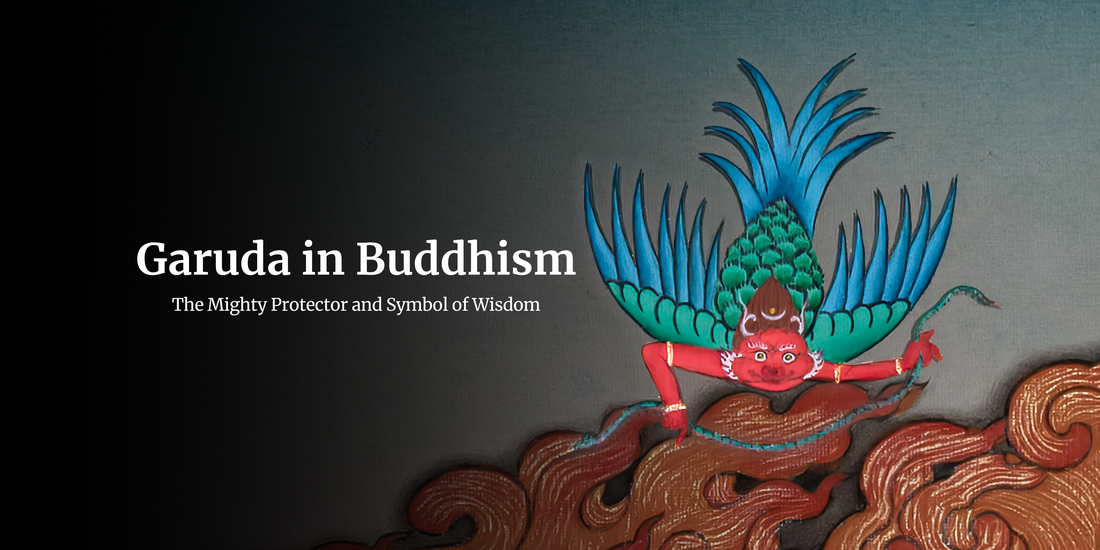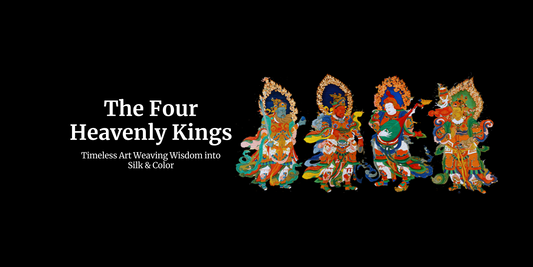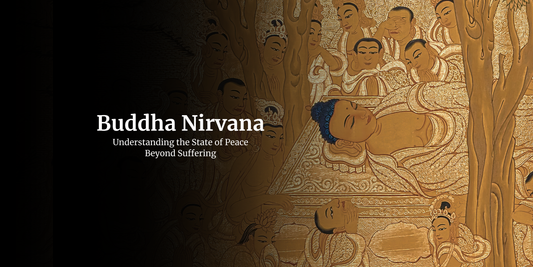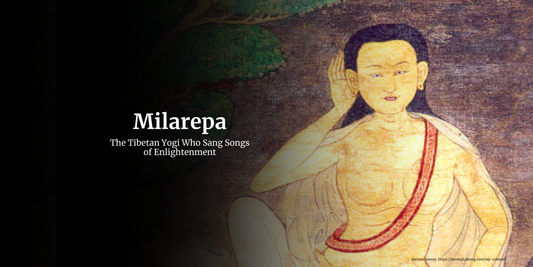- Buddhas Art of Healing
- Buddhism Blog | Teachings, Philosophy & Mindful Living
- Garuda in Buddhism: The Mighty Protector and Symbol of Wisdom

Garuda in Buddhism: The Mighty Protector and Symbol of Wisdom
We all know birds, right? Tiny, chirping, fluttery. But do you know there’s a bird that is enormous in size? The one who teaches wisdom, protects, and inspires courage. The bird is known as Garuda.
Garuda is one of the most powerful non-human mythical beings in Buddhism.
Unpredictable, isn't it? Garuda is not a myth; it reminds us of the inner strength we have. Let's see what makes him so extraordinary.
Origins of Garuda in Indian and Buddhist Tradition
The story of Garuda begins in ancient Indian mythology, where he is described in the great epics such as the Vedas, the Mahabharata, and the Ramayana.
Born to Rishi Kashyapa and Vinata, he emerged completely bright and powerful after a long incubation.
In Hinduism, he is celebrated for recovering Amrita (nectar of immortality) from heaven to free his mother from bondage to the serpent beings, or Nagas.
In Buddhism, Garuda (also known as Garula or Suparna) is described as one of a huge, intelligent bird-being and Aṣṭagatyaḥ (eight types of nonhuman beings).
With vast wings and the ability to take human form, he remains in eternal conflict with Nagas, symbolizing the cosmic struggle of knowledge vs. ignorance.
He appears in Buddhist arts as the patron of religion and the patron of knowledge. Garuda is a symbol of power, speed, and divine protection.
His fight with the Nagas represents the victory of enlightenment over confusion and the victory of knowledge over the samsara.
Key aspects of Garuda mythology in Buddhism:
-
Patron of Dharma: Protects the teachings of Buddhism, ensuring that the practitioners can follow the path without any hindrance.
-
Symbol of enlightenment: The fight with the Nagas is a symbol of clarity and insight over attachment, fear, and delusion.
- Supernatural abilities: Rich in immense power and speed and capable of flying between the realms, representing the immense nature of knowledge.
Iconography of Garuda in Buddhism
In Buddhism, the Garuda iconography depicts a powerful mythological bird with a human torso, eagle-like beak, and large wings.
Gaurda is usually shown trampling the serpents, representing victory over poison and negativity.
|
Iconography aspect |
Description |
|
Form and appearance |
Mythical bird with human torso and arms; eagle-like beak, and large outstretched wings |
|
Colors |
Golden yellow or multicolored, symbolizing cosmic elements |
|
Special features |
Flaming eyebrows/hair; jewel crown, and indestructible beak and talons |
|
Serpent motif |
Holds or tramples Nagas representing conquest over poison and negativity |
|
Posture and gesture |
Wings spread wide to signify power; sometimes shown in protective or fierce stance |
|
Eyes and crown symbols |
Golden eyes, crown with jewels, sun and moon symbols representing cosmic balance and energy |
You can browse our Dorje Drolo thangka collection, featuring Garuda prominently at the top.
Garuda as a Protector in Buddhist Practice
Beyond myth, Garuda acts as a parent deity in Buddhist practice.
- Protects practitioners from harm
- Provides protection against snake bites, poison, and spiritual obstacles; it is a symbol of his eternal struggle with Nagas.
- In Vajrayana Buddhism, the wrathful forms of Garuda are invited in rituals to eliminate disease and destroy negativity and obstruction of karmic deeds.
- Symbolizes a shield of wisdom, fearlessness, and compassion for those on the path of enlightenment.
In Tibetan thangka paintings, Garuda is often shown dynamically defeating Nagas, reminding practitioners that wisdom and spiritual insight can overcome ignorance and suffering.
Overview of Garuda’s Origins and Symbolism
|
Aspect |
Description |
|
Origin |
In Hindu mythology, Garuda was the son of sage Kashyapa and Cinata, who was born of an egg after 500 years of incubation. Buddhism adopted this origin by re-explaining him within its cosmology. |
|
Nature |
A huge, intelligent, bird-like being, in Buddhist tradition, falls under eight classes of nonhuman beings. |
|
Symbolism |
To embrace strength, speed, and divine protection. Represents the victory of wisdom over ignorance, as well as cosmic enmity with serpents. |
|
Iconography |
Often shown clutching in his talons, Garuda appears in both eagle-like and human-bird hybrid forms. He is revered as a protector of the Dharma. |
|
Cultural Importance |
Across Buddhist Asia, he is honored as a parent deity, a powerful symbol of wisdom, courage, and spiritual authority. |
In short, the mythology of Garuda in Buddhism merges from the ancient Indian roots with Buddhist spiritual symbolism and highlights the victory over ignorance and illusion and enlightened wisdom.
Symbolic Meaning in Buddhism
-
Overcoming Ignorance: His eternal battle with Nāgas illustrates the necessity of cultivating wisdom over delusion.
-
Freedom and Liberation: Soaring through the skies, Garuda symbolizes the liberated mind, free from fear and attachments.
- Spiritual Vigilance: His protective qualities remind practitioners to remain alert and dedicated on the path to enlightenment.

1. Who is Garuda in mythology?
Garuda is a hybrid form of human and bird, born from sage Kashyapa and Vinata after 500 years of incubation. In Buddhism, he is distinguished as a patron of dharma.
2. What does Garuda symbolize?
Garuda symbolizes power, speed, security, and victory over evil. In Buddhism, he represents the power to remove obstacles and build courage.
3. What is the role of Garuda in Buddhism?
In the Buddhist tradition, Garuda is a protector associated with wisdom, strength, and freedom from suffering.
4. Why are Garuda and Naga enemies?
Garuda and Nagas are enemies because the Naga’s mother enslaved Garuda’s mother. To free her, Garuda had to fight the serpents, symbolizing their natural rivalry of predator and prey.
In Buddhism, the Garuda bird is more than a mythical creature—he is a living symbol of spiritual power, knowledge, and safety. Garuda inspires the seekers to rise above fear and ignorance, embrace clarity, and cultivate courage.
For those seeking deep understanding and spiritual relations, our Buddhist deity Thangka collection provides rich insight and authentic art that enhances mindfulness and practice.
Discover Buddha's Art of Healing for authentic handmade thangkas.
You can also get connected with us on our Facebook and Instagram.



